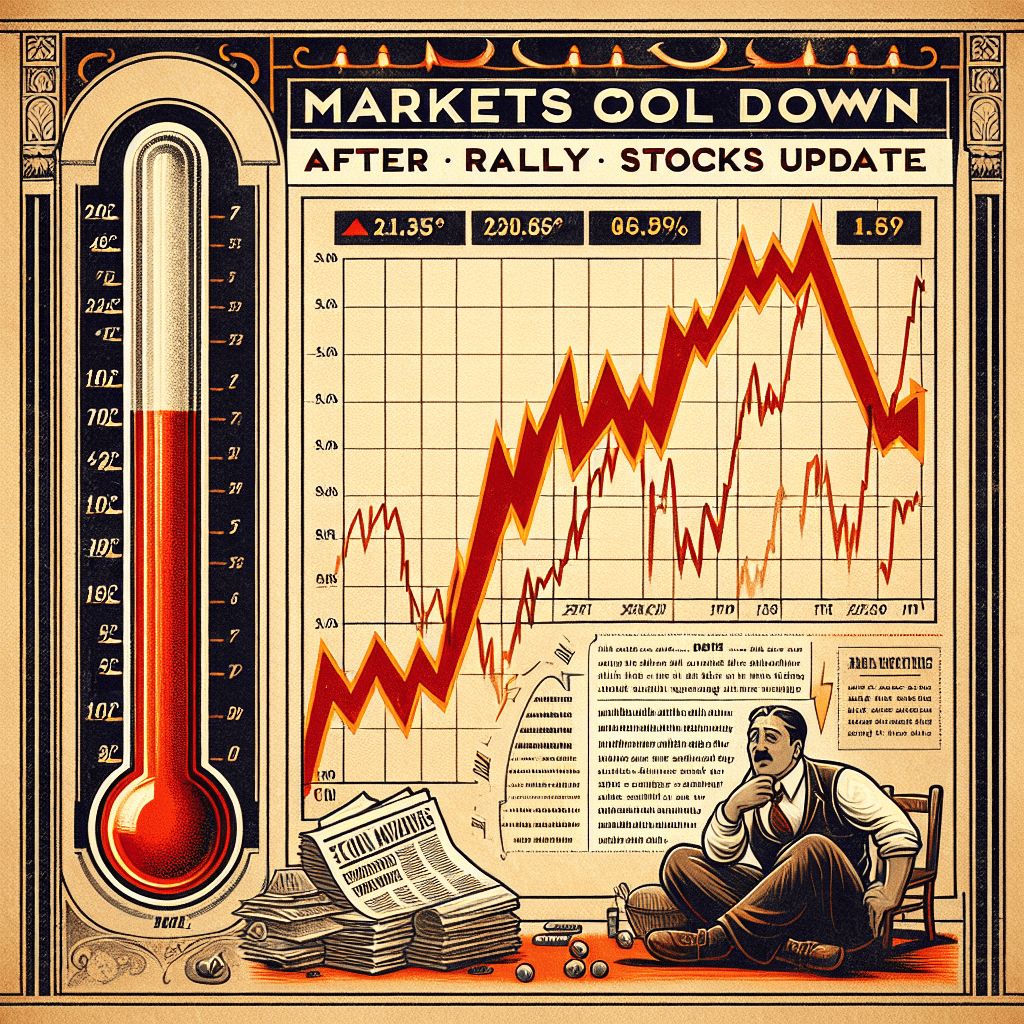“Stocks Take a Breather: Navigating the Calm After the Surge”
Introduction
In recent trading sessions, global markets have experienced a noticeable cooling off following a period of rapid gains. Investors are recalibrating their strategies as they digest a mix of economic data, corporate earnings reports, and geopolitical developments. The initial rally, fueled by optimism over economic recovery and accommodative monetary policies, has given way to a more cautious approach as market participants assess potential risks and the sustainability of growth. This shift in sentiment is reflected in the fluctuating stock indices, with some sectors experiencing more pronounced volatility than others. As the markets adjust, analysts are closely monitoring key indicators to gauge the future trajectory of stocks and the broader economic landscape.
Analysis Of The Recent Stock Market Rally
The recent stock market rally, characterized by a swift and robust ascent, has captured the attention of investors and analysts alike. However, as the markets begin to cool down, it is essential to analyze the factors that contributed to this rapid rally and the implications of the current slowdown. Understanding these dynamics can provide valuable insights into future market behavior and investment strategies.
Initially, the rally was fueled by a confluence of positive economic indicators and investor optimism. A series of strong corporate earnings reports, coupled with encouraging economic data, bolstered confidence in the market’s upward trajectory. Additionally, central banks around the world maintained accommodative monetary policies, providing ample liquidity and keeping interest rates low. This environment created a fertile ground for equities to flourish, as investors sought higher returns in the stock market compared to the relatively low yields offered by bonds.
Moreover, the rally was further propelled by technological advancements and innovation, particularly in sectors such as technology and renewable energy. Companies in these industries experienced significant growth, driven by increased demand for digital solutions and sustainable practices. As a result, investors flocked to these sectors, pushing stock prices to new heights. The enthusiasm surrounding these industries was not unfounded, as they represent long-term growth opportunities in an increasingly digital and environmentally conscious world.
However, as the rally progressed, concerns began to emerge regarding the sustainability of such rapid gains. Valuations in certain sectors reached historically high levels, prompting fears of a potential market correction. Investors started to question whether the pace of growth was justified by underlying fundamentals or if it was merely a product of speculative fervor. This apprehension was exacerbated by geopolitical tensions and uncertainties surrounding global trade, which introduced additional volatility into the markets.
In response to these concerns, a cooling down of the markets was observed. Investors began to reassess their positions, leading to a more cautious approach. Profit-taking became more prevalent, as market participants sought to lock in gains amid the growing uncertainty. This shift in sentiment was reflected in increased market volatility, with stock prices experiencing more frequent fluctuations.
Despite the recent cooling, it is important to recognize that market corrections are a natural part of the investment cycle. They serve to recalibrate valuations and provide opportunities for investors to reassess their strategies. While short-term fluctuations can be unsettling, they often pave the way for more sustainable long-term growth. In this context, the current slowdown should not be viewed solely as a negative development but rather as a necessary adjustment following a period of rapid expansion.
Looking ahead, investors should remain vigilant and adaptable, considering both the risks and opportunities that lie ahead. Diversification remains a key strategy, as it can help mitigate potential losses during periods of heightened volatility. Additionally, maintaining a long-term perspective is crucial, as it allows investors to weather short-term market fluctuations and capitalize on future growth prospects.
In conclusion, the recent stock market rally and subsequent cooling down highlight the dynamic nature of financial markets. While the rapid ascent was driven by a combination of positive economic indicators and investor enthusiasm, the current slowdown serves as a reminder of the inherent risks and uncertainties. By analyzing these developments and adopting a prudent investment approach, market participants can navigate the evolving landscape with greater confidence and resilience.
Factors Contributing To The Market Cool Down
In recent weeks, the financial markets have experienced a noticeable cooling down following a rapid rally that had investors and analysts alike buzzing with excitement. This shift in momentum can be attributed to a confluence of factors that have collectively contributed to the current market environment. Understanding these factors is crucial for investors seeking to navigate the complexities of the financial landscape.
To begin with, one of the primary factors influencing the market cool down is the recent adjustments in monetary policy by central banks around the world. After a prolonged period of accommodative monetary policies, characterized by low interest rates and quantitative easing, central banks have signaled a shift towards tightening. This change is largely driven by concerns over rising inflation, which has been exacerbated by supply chain disruptions and increased consumer demand. As central banks raise interest rates to combat inflation, borrowing costs for businesses and consumers increase, leading to a potential slowdown in economic activity. Consequently, investors have become more cautious, reassessing their risk exposure and adjusting their portfolios accordingly.
In addition to monetary policy changes, geopolitical tensions have also played a significant role in cooling down the markets. Ongoing conflicts and diplomatic standoffs in various regions have heightened uncertainty, prompting investors to adopt a more risk-averse stance. For instance, trade disputes between major economies have led to concerns over potential disruptions in global trade, which could adversely impact corporate earnings and economic growth. As a result, market participants have been more inclined to seek safe-haven assets, such as government bonds and gold, further contributing to the cooling of equity markets.
Moreover, corporate earnings reports have provided mixed signals, adding another layer of complexity to the market dynamics. While some companies have reported robust earnings, driven by strong consumer demand and operational efficiencies, others have faced challenges related to rising input costs and labor shortages. This divergence in corporate performance has led to increased volatility, as investors grapple with the task of discerning which sectors and companies are best positioned to thrive in the current environment. Consequently, the initial exuberance that fueled the rapid rally has given way to a more measured and selective approach to investing.
Furthermore, the resurgence of COVID-19 cases in certain regions has reignited concerns about the potential for renewed restrictions and their impact on economic recovery. Although vaccination efforts have made significant progress, the emergence of new variants poses a risk to the pace of reopening and normalization. This uncertainty has prompted investors to reassess their growth expectations, leading to a more cautious outlook for the markets.
Lastly, it is important to consider the psychological aspect of market behavior. After a period of rapid gains, it is not uncommon for investors to engage in profit-taking, locking in gains and reducing exposure to riskier assets. This behavior can create downward pressure on stock prices, contributing to the overall cooling of the markets.
In conclusion, the recent cool down in the markets can be attributed to a combination of factors, including changes in monetary policy, geopolitical tensions, mixed corporate earnings, COVID-19 uncertainties, and investor psychology. As these elements continue to evolve, market participants will need to remain vigilant and adaptable, carefully weighing the risks and opportunities that lie ahead. By understanding the underlying drivers of the current market environment, investors can make more informed decisions and better position themselves for future developments.
Impact Of Economic Indicators On Stock Performance
In recent months, the stock market has experienced a notable cooling down following a period of rapid rally, a phenomenon that has captured the attention of investors and analysts alike. This shift in market dynamics can be largely attributed to the impact of various economic indicators, which have played a crucial role in shaping investor sentiment and influencing stock performance. As we delve into the intricacies of these economic indicators, it becomes evident that their influence extends beyond mere numbers, affecting the broader economic landscape and, consequently, the stock market.
To begin with, inflation rates have been a significant factor in the recent cooling of the stock market. As inflationary pressures mount, central banks around the world have been compelled to adjust their monetary policies, often opting for interest rate hikes to curb rising prices. These adjustments, while necessary to maintain economic stability, have a direct impact on stock performance. Higher interest rates tend to increase the cost of borrowing, which can dampen corporate profits and, in turn, lead to a decline in stock prices. Moreover, as investors seek safer returns, they may shift their focus from equities to fixed-income securities, further contributing to the cooling of the stock market.
In addition to inflation, employment data has also played a pivotal role in shaping market trends. Strong employment figures often signal a robust economy, which can boost investor confidence and drive stock prices higher. However, the recent cooling of the market suggests a more complex interplay between employment data and stock performance. While low unemployment rates are generally positive, they can also lead to wage inflation, which may squeeze corporate margins and weigh on stock valuations. Furthermore, as the labor market tightens, companies may face challenges in attracting and retaining talent, potentially impacting their long-term growth prospects.
Another critical economic indicator influencing stock performance is consumer confidence. This metric provides insight into the overall sentiment of consumers regarding their financial situation and the broader economy. High consumer confidence typically translates into increased consumer spending, which can bolster corporate revenues and support stock prices. However, recent fluctuations in consumer confidence have contributed to the cooling of the stock market. Concerns over inflation, geopolitical tensions, and potential economic slowdowns have led to a more cautious consumer outlook, which has, in turn, tempered investor enthusiasm.
Moreover, global economic conditions have also played a significant role in the recent market dynamics. As economies around the world grapple with various challenges, including supply chain disruptions and geopolitical uncertainties, the interconnectedness of global markets means that these issues can have far-reaching implications for stock performance. For instance, disruptions in global trade can impact corporate earnings, while geopolitical tensions can lead to increased market volatility, both of which can contribute to a cooling of the stock market.
In conclusion, the recent cooling of the stock market following a rapid rally can be attributed to the complex interplay of various economic indicators. Inflation rates, employment data, consumer confidence, and global economic conditions all play a crucial role in shaping investor sentiment and influencing stock performance. As these indicators continue to evolve, investors must remain vigilant and adapt their strategies accordingly to navigate the ever-changing market landscape. By understanding the impact of these economic indicators, investors can make more informed decisions and better position themselves for future market developments.
Investor Sentiment During Market Fluctuations

Investor sentiment plays a crucial role in the dynamics of financial markets, often acting as both a catalyst and a barometer for market movements. Recently, markets have experienced a cooling period following a rapid rally, prompting investors to reassess their positions and strategies. This shift in sentiment is not uncommon, as markets are inherently cyclical, characterized by periods of exuberance followed by phases of consolidation or correction. Understanding the underlying factors that drive these fluctuations can provide valuable insights for investors seeking to navigate the complexities of the financial landscape.
Initially, the rapid rally was fueled by a confluence of positive economic indicators, robust corporate earnings, and accommodative monetary policies. These factors collectively bolstered investor confidence, leading to a surge in stock prices across various sectors. However, as valuations soared, concerns about potential overvaluation began to surface. This apprehension was further exacerbated by geopolitical tensions and uncertainties surrounding global trade policies, which introduced an element of risk that investors could not ignore.
As the rally reached its peak, market participants started to exhibit signs of caution, leading to a gradual cooling of the markets. This shift was marked by increased volatility, as investors grappled with the dual forces of optimism and prudence. During such periods, investor sentiment often becomes more nuanced, reflecting a balance between the desire to capitalize on potential gains and the need to mitigate risks. Consequently, some investors opted to lock in profits, while others adopted a more defensive stance, reallocating their portfolios to include safer assets such as bonds or gold.
Moreover, the role of institutional investors cannot be overlooked in shaping market sentiment. These entities, with their vast resources and sophisticated analytical tools, often set the tone for broader market trends. As they adjusted their strategies in response to changing market conditions, retail investors followed suit, amplifying the cooling effect. This interplay between different classes of investors underscores the complexity of market dynamics and the importance of sentiment in driving market behavior.
In addition to these factors, external influences such as central bank policies and macroeconomic data releases also played a pivotal role in shaping investor sentiment. For instance, hints of tightening monetary policy or disappointing economic data can quickly dampen enthusiasm, prompting a reevaluation of market prospects. Conversely, positive developments in these areas can reignite optimism, leading to renewed buying interest. Thus, investors must remain vigilant, continuously monitoring these variables to make informed decisions.
As markets continue to cool, it is essential for investors to maintain a long-term perspective. While short-term fluctuations can be unsettling, they are an inherent part of the investment landscape. By focusing on fundamental analysis and maintaining a diversified portfolio, investors can better withstand the ebbs and flows of market sentiment. Furthermore, periods of market cooling can present opportunities for astute investors to identify undervalued assets and position themselves for future growth.
In conclusion, the recent cooling of markets following a rapid rally highlights the intricate relationship between investor sentiment and market fluctuations. By understanding the factors that drive these changes, investors can better navigate the challenges and opportunities that arise in the ever-evolving financial markets. As always, a disciplined approach, grounded in sound analysis and a clear understanding of one’s investment objectives, remains the cornerstone of successful investing.
Sector-Specific Performance In A Cooling Market
In recent weeks, the financial markets have experienced a noticeable cooling after a period of rapid rally, prompting investors to reassess their strategies and focus on sector-specific performance. This shift in market dynamics has been influenced by a combination of factors, including economic indicators, geopolitical tensions, and central bank policies. As the broader market takes a breather, it becomes increasingly important to examine how different sectors are performing in this cooling environment.
To begin with, the technology sector, which has been a significant driver of the recent rally, is now facing a period of consolidation. After experiencing substantial gains, tech stocks are seeing a moderation in their upward momentum. This can be attributed to concerns over high valuations and potential regulatory challenges. However, despite these headwinds, the sector remains resilient due to its fundamental role in the digital transformation of various industries. Investors are now more discerning, focusing on companies with strong earnings growth and innovative capabilities.
Meanwhile, the healthcare sector is demonstrating a mixed performance. On one hand, pharmaceutical companies continue to benefit from robust demand for their products, particularly in the wake of ongoing global health challenges. On the other hand, healthcare providers are grappling with rising operational costs and regulatory pressures. This dichotomy within the sector underscores the importance of careful stock selection, as investors seek to balance growth opportunities with potential risks.
In contrast, the energy sector is experiencing a resurgence, driven by rising oil prices and increased demand for renewable energy solutions. Traditional oil and gas companies are benefiting from higher commodity prices, which have been bolstered by geopolitical tensions and supply chain disruptions. Simultaneously, the push towards sustainable energy is gaining momentum, with renewable energy firms attracting significant investment. This dual trend highlights the sector’s evolving landscape, where both conventional and alternative energy sources play crucial roles.
The financial sector, too, is navigating a complex environment. Banks and financial institutions are benefiting from rising interest rates, which have improved their net interest margins. However, they are also contending with regulatory changes and the potential for increased loan defaults as economic conditions fluctuate. In this context, financial firms with diversified revenue streams and strong risk management practices are better positioned to weather the cooling market.
Furthermore, the consumer discretionary sector is facing challenges as inflationary pressures impact consumer spending patterns. While some companies are successfully passing on higher costs to consumers, others are struggling to maintain profit margins. This sector’s performance is closely tied to consumer confidence, which remains volatile amid economic uncertainties. As a result, investors are paying close attention to companies with strong brand loyalty and pricing power.
Lastly, the industrial sector is showing resilience, supported by infrastructure investments and a rebound in manufacturing activity. Supply chain disruptions continue to pose challenges, but companies with robust logistics and supply chain management capabilities are better equipped to navigate these hurdles. The sector’s performance is also linked to global trade dynamics, which remain a key area of focus for market participants.
In conclusion, as the markets cool down after a rapid rally, sector-specific performance becomes increasingly critical for investors seeking to optimize their portfolios. By understanding the unique dynamics and challenges facing each sector, investors can make informed decisions that align with their risk tolerance and investment objectives. As the market landscape continues to evolve, staying attuned to these sectoral shifts will be essential for navigating the complexities of a cooling market.
Strategies For Navigating A Volatile Stock Market
In the wake of a rapid rally that saw stock markets reach unprecedented highs, investors are now witnessing a cooling period characterized by increased volatility and uncertainty. This shift in market dynamics necessitates a strategic approach to navigating the complexities of a volatile stock market. Understanding the underlying factors contributing to this volatility is crucial for investors aiming to make informed decisions. Several elements, including geopolitical tensions, fluctuating interest rates, and economic indicators, play a significant role in shaping market behavior. As these factors continue to evolve, they contribute to the unpredictability that investors must contend with.
To effectively navigate this environment, diversification remains a cornerstone strategy. By spreading investments across various asset classes, sectors, and geographical regions, investors can mitigate risks associated with market volatility. This approach not only helps in cushioning the impact of market downturns but also positions investors to capitalize on potential upswings in different areas. Moreover, diversification can provide a balanced exposure to both growth and value stocks, allowing investors to benefit from different market cycles.
In addition to diversification, maintaining a long-term perspective is essential. While short-term market fluctuations can be unsettling, it is important to remember that markets have historically trended upwards over extended periods. By focusing on long-term goals and avoiding impulsive decisions based on short-term market movements, investors can better withstand periods of volatility. This approach requires discipline and patience, as well as a clear understanding of one’s investment objectives and risk tolerance.
Furthermore, staying informed about market trends and economic developments is vital for making sound investment decisions. Regularly reviewing financial news, market analyses, and expert opinions can provide valuable insights into potential market shifts. This knowledge enables investors to adjust their strategies proactively, rather than reactively, in response to changing market conditions. Additionally, leveraging technology and analytical tools can enhance an investor’s ability to monitor market trends and identify opportunities.
Another effective strategy is to maintain a flexible investment approach. This involves being open to adjusting one’s portfolio in response to evolving market conditions. For instance, during periods of heightened volatility, investors might consider increasing their allocation to defensive stocks or sectors that tend to perform well in uncertain times, such as utilities or consumer staples. Conversely, when markets stabilize, reallocating towards growth-oriented investments may be advantageous. This flexibility allows investors to adapt to market changes while still aligning with their overall investment strategy.
Moreover, consulting with financial advisors or investment professionals can provide valuable guidance in navigating a volatile market. These experts can offer personalized advice based on an individual’s financial situation, goals, and risk tolerance. By working with professionals, investors can gain access to a wealth of knowledge and experience, which can be instrumental in making informed decisions during uncertain times.
In conclusion, while the cooling of markets after a rapid rally presents challenges, it also offers opportunities for strategic investors. By employing a combination of diversification, long-term focus, informed decision-making, flexibility, and professional guidance, investors can effectively navigate the complexities of a volatile stock market. As market conditions continue to evolve, these strategies will remain essential tools for achieving financial success and resilience in the face of uncertainty.
Long-Term Implications Of Short-Term Market Changes
In recent months, financial markets have experienced a notable cooling period following a rapid rally that captured the attention of investors worldwide. This shift in market dynamics has prompted analysts and investors alike to consider the long-term implications of these short-term changes. Understanding the underlying factors that contribute to such market fluctuations is crucial for making informed investment decisions and anticipating future trends.
Initially, the rapid rally was driven by a confluence of factors, including robust corporate earnings, accommodative monetary policies, and a resurgence in consumer confidence. These elements combined to create an environment ripe for growth, propelling stock prices to unprecedented heights. However, as is often the case in financial markets, what goes up must eventually come down. The recent cooling of markets can be attributed to a variety of factors, including concerns over inflation, geopolitical tensions, and the potential for tighter monetary policies.
As markets cool, investors are faced with the challenge of reassessing their portfolios and strategies. While short-term market changes can be unsettling, they also present opportunities for those who are able to navigate the volatility with a clear understanding of the broader economic landscape. For instance, a cooling market may provide a more favorable entry point for long-term investors seeking to acquire quality assets at more reasonable valuations. Moreover, it encourages a shift in focus from short-term gains to sustainable growth, prompting investors to prioritize companies with strong fundamentals and resilient business models.
In addition to influencing individual investment strategies, short-term market changes can have broader implications for the economy as a whole. A cooling market may signal a period of economic recalibration, where excesses are corrected, and growth is realigned with underlying economic realities. This process, while potentially painful in the short term, can ultimately lead to a more stable and sustainable economic environment. Furthermore, it can prompt policymakers to reevaluate their approaches, balancing the need for economic growth with the imperative to maintain financial stability.
The cooling of markets also underscores the importance of diversification as a risk management strategy. By spreading investments across a range of asset classes, sectors, and geographies, investors can mitigate the impact of market volatility on their portfolios. This approach not only helps to preserve capital during downturns but also positions investors to capitalize on opportunities as markets recover.
Moreover, the recent market cooling serves as a reminder of the cyclical nature of financial markets. While periods of rapid growth can be exhilarating, they are often followed by corrections that serve to temper exuberance and restore balance. Recognizing this cyclical pattern is essential for maintaining a long-term perspective and avoiding the pitfalls of short-term thinking.
In conclusion, while the recent cooling of markets following a rapid rally may cause concern among investors, it is important to view these changes within the context of broader economic trends and cycles. By focusing on long-term fundamentals, maintaining a diversified portfolio, and remaining attuned to the evolving economic landscape, investors can navigate the challenges and opportunities presented by short-term market changes. Ultimately, understanding the long-term implications of these fluctuations is key to achieving sustainable investment success in an ever-changing financial environment.
Q&A
1. **What caused the markets to cool down after the rapid rally?**
– The markets cooled down due to profit-taking by investors, concerns over economic data, and potential interest rate hikes by central banks.
2. **Which sectors were most affected by the market cooldown?**
– Technology and consumer discretionary sectors were most affected as investors rotated into more defensive sectors like utilities and healthcare.
3. **How did global markets react to the cooldown in U.S. stocks?**
– Global markets experienced a mixed reaction, with some Asian and European markets also seeing declines, while others remained stable due to local economic factors.
4. **What role did economic data play in the market cooldown?**
– Economic data indicating slower growth or higher inflation contributed to investor concerns, leading to a reassessment of stock valuations and future earnings potential.
5. **How did bond yields impact the stock market during this period?**
– Rising bond yields made fixed-income investments more attractive compared to stocks, prompting some investors to shift their portfolios away from equities.
6. **What are analysts predicting for the stock market in the near future?**
– Analysts are predicting increased volatility with potential for further corrections, but some remain optimistic about long-term growth prospects depending on economic recovery and corporate earnings.
7. **How did major indices perform during the market cooldown?**
– Major indices like the S&P 500, Dow Jones Industrial Average, and NASDAQ Composite saw declines, with the NASDAQ experiencing the most significant drop due to its tech-heavy composition.
Conclusion
The recent cooling of markets following a rapid rally suggests a period of consolidation and potential recalibration among investors. After a swift upward movement, it is common for markets to experience a pullback as participants reassess valuations and economic conditions. This cooling phase may indicate a shift towards more cautious sentiment, with investors possibly taking profits or adjusting portfolios in response to changing macroeconomic indicators or geopolitical developments. While the rally demonstrated strong investor confidence, the subsequent cooldown highlights the inherent volatility and unpredictability of financial markets. Moving forward, market participants will likely focus on key economic data releases, corporate earnings, and central bank policies to gauge the sustainability of future market movements.





